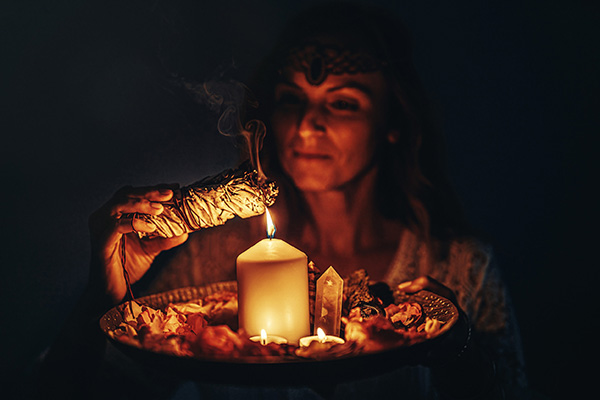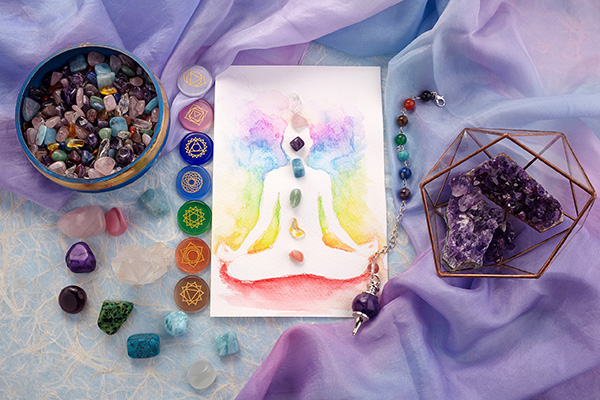Comprehending the Heritage of Smudging in Spiritual Customs
 Much like how our physical spaces can become disorganized and filthy, our aura or energy field can also gather stagnant and adverse energy.
Much like how our physical spaces can become disorganized and filthy, our aura or energy field can also gather stagnant and adverse energy.
Consistently tidying up our homes and workplaces enhances health, cleanliness, and efficient function — and the same concept applies to our internal and spiritual energies. Purging our energy field and environment aids in dispelling negativity, harmful emotions, stress, and anxiety, and fosters a sense of tranquility, clarity, and equilibrium.
Cleansing energy is crucial for eliminating blockages that might impede personal and spiritual progress or interrupt your connection with spirit and the divine. Over time, lingering negative or toxic energies can even lead to mental health issues, spiritual disconnection, and physical ailments.
By maintaining a regular energy-cleansing regimen, you cultivate a vibrant, harmonious flow of energy that supports overall health and well-being. Moreover, a clear energy field enhances your intuition and inner guidance, simplifying alignment with your higher self and making choices that resonate with your greater good.
Smudging serves as a powerful method to eliminate negative energy attachments and drive away malevolent spiritual entities.
One of the most effective and enduring techniques for removing unwanted energy is smudging, or smoke cleansing — an ancient purification ritual rich in history and practiced by diverse cultures, religions, and spiritual traditions across the globe.
This practice involves igniting sacred herbs, fragrant plants, woods, or resins to purify a person, space, or object. The smoke produced during smudging is thought to cleanse negative energy, purify the atmosphere, and promote healing and wellness. Smudging is frequently utilized to prepare a space for meditation, prayer, or other spiritual endeavors by establishing a sacred environment for focused intention.
Many individuals engage in smudging before any other ceremony, to kick off the day, or before and after significant discussions. For us, this truly is a meaningful ceremony. After performing it, we feel rejuvenated, our energy appears lighter, and the day flows more smoothly ~ Shannon Thomas
Beyond its practical advantages, smudging is a profoundly spiritual practice. It connects us to the fundamental elements of fire, air, and earth, to our intentions, and to the universal energies flowing through all existence. Indigenous communities in North America traditionally engage in smudging to honor the spiritual realm, convey prayers, and enhance healing. The ritual not only dispels negativity but also invites light, positivity, and harmony, making way for healing, growth, and connection to the divine.
The Origins Of Smudging
The term “smudging” is particularly linked to the spiritual customs of the indigenous tribes of North America, where it holds significant cultural and ceremonial importance. Among groups like the Lakota, Cherokee, and others, smudging is utilized to purify spaces, individuals, and objects, as well as to invoke blessings, protection, and guidance from the spirit world. The herbs employed — including sage, cedar, and sweetgrass — are regarded as sacred gifts from Mother Earth and are harvested with profound respect, accompanied by prayers of gratitude.
Within Native American traditions, smudging often accompanies major ceremonies, including healing rituals, vision quests, and sweat lodges. It is significantly more than a mere cleansing procedure; it is a sacred communication with the spiritual realm, a method of honoring ancestors, and an acknowledgment of the interconnectedness of all life. Furthermore, smudging is performed to repel evil spirits and guard against negative influences, reinforcing its purifying and protective functions.
At its essence, smudging resembles incense burning — a practice of creating smoke from natural materials to achieve purification, protection, and sanctification. This idea transcends cultural boundaries, appearing in spiritual traditions globally, with each culture adapting it to their unique beliefs and practices. The burning of herbs, woods, and resins acts as a connection between the seen and unseen worlds, fostering a bond with the divine and aligning practitioners with universal energies.
Different cultures utilize varying substances, such as resins like frankincense and myrrh or herbs like sandalwood and lavender, for purposes ranging from meditation and prayer to healing and creating sacred environments, deterring malevolence. For instance, in Mesoamerican societies, copal resin has been burned for centuries in spiritual ceremonies for purification and safeguarding. In Australian Aboriginal customs, eucalyptus leaves are ignited in cleansing and healing rituals.
Traditional healers in Southern African communities, known as sangoma, use imphepho, a perennial herb indigenous to the region and part of the daisy family. Imphepho is utilized in rituals to cleanse spaces, individuals, and objects, dispel negative energies, and foster a sacred ambiance. The smoke is believed to facilitate communication with ancestral spirits, facilitating guidance, healing, and blessings.
Incense smoke also holds profound symbolic and ritual significance across various religious traditions, serving as a bridge between the physical and spiritual realms:
Buddhism: Incense is offered to the Buddha as a gesture of reverence and to purify the environment for meditation, temple rituals, and ceremonies. The ascending smoke symbolizes the transience of life and the pursuit of spiritual enlightenment.
Hinduism: Incense is vital to daily worship, rituals, and festivals, creating a sacred atmosphere and revering deities. It is often used in pujas (prayer rituals) to invite divine presence and blessings.
Shinto: Incense is burned at shrines to purify the space and as an offering to kami spirits or deities honored in Shinto faith. This practice fosters harmony between humans and the divine.
Taoism: Incense plays a significant role in Taoist rituals, honoring deities and ancestors while purifying ceremonial settings. It signifies a connection to the Tao (the ultimate principle).
Judaism: Historically, incense was a core component of rituals in the ancient Temple in Jerusalem, symbolizing holiness and divine connection. Today, some Jewish traditions incorporate spices and fragrant herbs in ceremonies like Havdalah, which marks the conclusion of the Sabbath and represents a separation between the sacred and the mundane.
Christianity: In Catholic, Orthodox, and certain Anglican traditions, incense represents prayers ascending to the heavens. It is utilized during liturgical services such as Mass, processions, and funeral rites, continuing a practice that has roots in the ancient temple in Jerusalem.
These varied practices of burning incense reflect an ancient, archetypal tradition of utilizing elemental forces — especially fire and air — for divine connection, energy transmutation, healing promotion, and enhanced harmony between the physical and spiritual realities.
Smudging and the burning of incense are timeless rituals that transcend cultural barriers because they encompass more than mere cleansing; they signify intention and transformation. Engaging with elemental forces such as fire and air allows us to tap into universal energies that amplify our desires and facilitate change. The smoke transports our intentions upwards, signaling our readiness to release what no longer serves us and embrace renewal to the divine and the universe.
This impactful practice also serves as a reminder of the interdependence of all things. The herbs we ignite are gifts from the earth, the smoke dances through the air, and the ashes regenerate the earth. In this cycle, we observe the harmonious balance of nature, a balance we endeavor to reflect in our lives.
The smoke from herbs like sage has the capability to capture positive ions in the air molecule and eliminate them. The positive ion is the electric charge in air that can be detrimental to you. It is suggested that these positive ions carry heavy, dense energies. Therefore, their removal helps to break down those energies ~ Luc Bourgault
Step-By-Step Guide To Smudging
Initiating your own smudging practice is a potent spiritual ritual for dispelling negative energy, protecting your aura, enhancing personal and spiritual wellness, and transforming your home or office into a sacred environment. Here’s a step-by-step guide to assist you in getting started:
SMUDGING MATERIALS
The materials you select will depend on the tradition you’re adhering to and your personal preferences. Commonly used smudging materials by contemporary practitioners include:
White Sage: Renowned for its cleansing qualities, frequently utilized in Native American traditions.
Sweetgrass: Associated with blessings and attracting positive energy.
Palo Santo: A South American wood employed for spiritual cleansing.
Copal or Incense: Resin used for purification and creating a sacred space.
If you are new to smudging, a great starting point is with white sage. Celebrated for its robust and fragrant aroma, sage has been a pillar of cleansing rituals for centuries. As you grow more familiar with the practice, you may wish to explore other herbs such as sweetgrass, cedar, or lavender. These can be blended to cater to your particular needs and preferences. Bundles of smudging herbs can often be found in esoteric shops, health food stores, and Native American markets.
As you become more proficient with smudging, you might feel inclined to expand or modify your practice. Consider crafting your own herbal blends tailored to specific needs. For instance:
For protection: Blend sage with cedar or rosemary.
For love and harmony: Mix lavender, rose petals, and sweetgrass.
For prosperity: Combine bay leaves, cinnamon, and basil.
You can also incorporate smudging into other spiritual practices like meditation, yoga, or candle rituals. The act of cleansing can amplify the energy of these activities, creating a deeper and more focused experience.
No matter which materials you choose for your smudging practice, it’s crucial to utilize only ethically and sustainably sourced ingredients to respect the natural world and the cultural traditions tied to this sacred practice. The excessive harvesting of specific plants, such as white sage and sweetgrass, has raised alarms about their depletion, especially in native regions. To ensure sustainability, seek herbal materials that are responsibly sourced, like those from reputable ethical suppliers or cultivated in controlled environments.
You might also consider growing your own herbs or utilizing alternatives like lavender, cedar, or palo santo that are ethically sourced from sustainable forests. Supporting eco-friendly practices guarantees that future generations can continue to reap the benefits of these healing traditions without exhausting vital resources. Furthermore, investing time in understanding the cultural significance of the materials you select nurtures a deeper connection to the practice and honors the communities that have historically relied on these plants.
SMUDGING TOOLS
You will need several tools for your smudging practice:
Smudge stick or loose herbs: You can purchase pre-made smudge bundles or create your own by fastening herbs together.
Smudge bowl or dish: This will collect the ash and embers. A ceramic or abalone bowl is typically employed.
Lighter, matches, or candle: To ignite the smudge stick or loose materials.
Feather or paper/fabric fan (optional): Used to circulate the smoke around your space or body.
Safe surface: Ensure you work on a non-flammable surface while handling fire.
SACRED SPACE
Before initiating your smudging ceremony, take a moment to prepare the ritual area. Select a safe spot devoid of fire hazards and ensure good ventilation by opening windows. Smudging is most effective in a serene, quiet environment that allows for focused attention. Prepare the space by removing any clutter. Light a candle or use soft lighting to cultivate a tranquil atmosphere. Play gentle, soothing music or chanting, if desired.
SMUDGING METHOD
One of the captivating aspects of smudging is its adaptability. There’s no single “correct” way to execute the ritual. Trust your instincts to guide you, allowing the process to unfold naturally. If a particular tradition resonates with you, consider learning more about it from a knowledgeable practitioner who can provide insights and wisdom to enrich your practice.
Set your intention: Before you commence your smudging ritual, take a few quiet moments to set a clear and intentional purpose. Whether you’re seeking to release negative energy from your home, invite guidance from the spiritual realm, or restore balance, articulate what you aim to achieve. Are you letting go of the hurt from a past relationship, clearing your space after a stressful incident, or seeking protection? Write down your intention or vocalize it — this act of verbalizing your purpose harmonizes your energy with your desires. The universe responds to intentional, focused energy.
Light the smudge: Ignite the tip of your smudge stick (or the herbs if using loose materials) with a match or lighter. Allow it to burn for several seconds, then gently blow out the flame, letting it smolder and release aromatic smoke. The smoke serves as a symbolic and energetic tool, signifying the removal of negativity and the infusion of light and positivity. Should you be employing loose herbs, place them in your smudge bowl or dish and ignite them, allowing natural smoke to form.
Smudge yourself, objects, or space: As the smoke rises, gently direct it to areas that require attention. As you progress through your practice, articulate or envision your intention, whether for protection, healing, or purification. Depending on your personal or spiritual inclination, you may choose to offer prayers or chants. This deepens the metaphysical potency of the ritual and reinforces your bond with the energies you’re invoking.
For personal cleansing: Hold the incense stick a safe distance from your body, guiding the smoke over yourself from head to toe. Envision the smoke washing away negativity, leaving you rejuvenated and revitalized. Use your hand, a feather, or a fan to maneuver the smoke.
For objects: Hold the item within the smoke, gently moving it to purify its energy.
For spaces: Slowly traverse the room, allowing the smoke to touch the corners, windows, doors, and any areas that feel heavy or stagnant. Focus on zones that feel energetically compromised, ensuring you cover every nook and cranny.
Extinguishing the smudge: Once the ritual feels completed, safely extinguish the smudge by pressing the tip into a bowl or dish, or using sand or soil. Confirm that the bundle is entirely extinguished and devoid of embers. Always prioritize fire safety — never leave a burning Smudge Stick unattended. The ashes symbolize the negativity or burdens you’ve cast off, and many choose to treat them with reverence. You may bury or scatter them with a prayer of gratitude or affirmation to return them to the earth.
Conclude the ritual: Express gratitude for the cleansing energy you’ve welcomed into your life. Thank the elements, ancestors, spirits, or divine sources that guided you. If you smudged a space, consider sealing the energy with a final affirmation of positivity, love, and light. Take a moment to reflect on the experience and observe how you feel — physically, emotionally, and spiritually. The act of smudging not only purifies but grounds us, enriching our connection to both our inner selves and the world around us.
Smudging is a powerful and ongoing practice. You can cleanse your space regularly — during seasonal transitions, after stressful occurrences, or when negative energy is detected. It can also serve as a ritual to signify life transitions, celebrate milestones, or maintain energetic harmony.
Honoring The Tradition
While smudging is an easily accessible practice, it’s vital to honor its origins and the indigenous communities that have preserved this sacred tradition. For many, smudging is not merely a routine but a profound spiritual practice passed through generations. Approach this sacred art with respect and appreciation, recognizing its roots and the people who have shared it with the world. Education plays a crucial role here — take the time to learn about smudging’s cultural significance and fight for practices that honor its origins.
Ethical and sustainable smudging begins with mindful sourcing. White sage, for instance, faces the threat of over-harvesting due to its rising demand. Whenever plausible, support indigenous-owned businesses or ethical suppliers dedicated to sustainability. Consider cultivating your own herbs, such as sage, lavender, or rosemary, to ensure a personalized and eco-friendly supply.
When harvesting herbs, always do so with respect for the earth. Offer a prayer of thanks, only take what you need, and be cautious not to contribute to the exploitation of sacred plants or the commercialization of spiritual practices. Practicing smudging with mindfulness and a commitment to sustainability not only honors tradition but aids in preserving it for future generations.
Smudging is a timeless ritual providing a pathway to purification, healing, and divine connection. Whether you are cleansing yourself, your surroundings, or an object, the act of smudging can significantly enhance your spiritual journey. As you light your first incense stick, approach the ritual with an open heart and clear intention. Trust in the power of the smoke to convey your desires, knowing that through this sacred endeavor, you are aligning yourself with the energies of the universe.
|
Mystic Shelley is a five-star psychic, Reiki healer, clairvoyant, and empathic reader. She provides her clients with truthful insights about past, present, and future events with the assistance of her reliable guides. Her readings encompass areas such as love, relationships, career, finances, and all matters of life. Mystic Shelley was born with gifts that eventually categorized her as a talented psychic, though she initially chose not to acknowledge them. In her 30s, a serendipitous encounter with a renowned psychic set her on a path that awakened her abilities. With the gifts of clairvoyance and empathy, her psychic mentor guided her to enhance those skills, elevating her talents to unprecedented levels. Through experience, she grew proficient, and today, she boasts a growing list of loyal clients who extol her virtues. Additionally, she has actively assisted fellow psychics in unlocking their potential. If you are in search of straightforward and truthful answers, schedule a reading with Mystic Shelley at PsychicAccess.com. |
Understanding the Historical Practice of Smudging in Spiritual Traditions
Smudging, a ritual entrenched in multiple spiritual traditions, has surged in popularity as individuals seek alternative techniques for cleansing and purifying their spaces. This age-old practice consists of burning sacred herbs and plants to produce smoke, believed to carry prayers, intentions, and positive energy. While smudging has garnered broader acceptance, it is crucial to grasp its historical context and cultural significance.
The roots of smudging extend back thousands of years and can be found in numerous indigenous cultures around the globe. Native American tribes, such as the Lakota, Navajo, and Apache, have long integrated smudging into their spiritual ceremonies. Similarly, the act has been a crucial component of the spiritual practices of indigenous peoples in Australia, Africa, and South America.
In these traditions, smudging serves as a means to connect with the spiritual realm, cleanse negative energies, and facilitate healing. The smoke is thought to carry prayers and intentions to the divine, acting as a bridge between the physical and spiritual domains. It is also utilized to purify individuals, items, and spaces, eliminating any stagnant or harmful energies.
The specific herbs and plants employed in smudging differ across cultural and regional practices. Commonly used herbs encompass sage, cedar, sweetgrass, lavender, and palo santo. Each herb is significant in its own right and contributes unique properties to the overall intention of the smudging ritual. For instance, sage is prominently used for cleansing and purifying, while sweetgrass is related to drawing in positive energy.
Typically, the process of smudging involves igniting the chosen herb or plant, allowing it to flame before extinguishing, leaving a glowing ember. The resulting smoke is directed using a feather or a hand to ensure all necessary areas receive cleansing or blessings. It is customary to smudge oneself, others, sacred objects, and living spaces like homes or ceremonial sites.
As smudging’s popularity has grown outside its indigenous roots, it’s essential to engage with this practice respectfully and knowledgeably. Cultural appropriation remains a significant concern since smudging is closely tied to indigenous spirituality and traditions. It is vital to educate oneself about the cultural importance and history of smudging, honoring its origins.
Additionally, obtaining the herbs and plants utilized for smudging from sustainable and ethical sources is crucial. Overharvesting of sacred plants like white sage has emerged as a pressing issue due to rising demand. Supporting local indigenous communities or purchasing from reputable sources prioritizing sustainability can help conserve these sacred plants for future generations.
In summary, smudging is an ancient practice deeply embedded in the spiritual traditions of various cultures across the world. It serves as a powerful tool for cleansing, purifying, and connecting with the spiritual realm. Understanding its historical significance and cultural context is paramount for engaging in this practice with respect and gratitude. By honoring its roots, utilizing sustainable resources, and educating ourselves, we can participate in smudging meaningfully and ethically. Continue reading

















